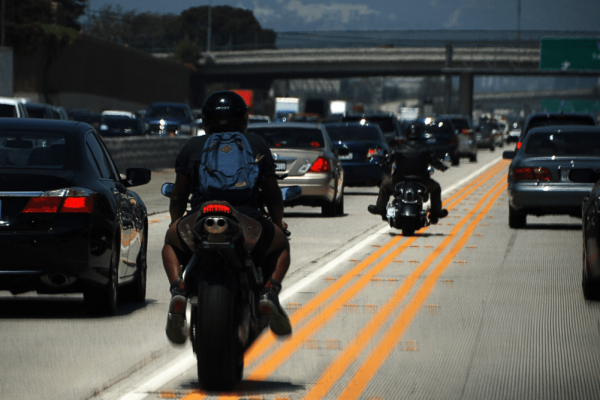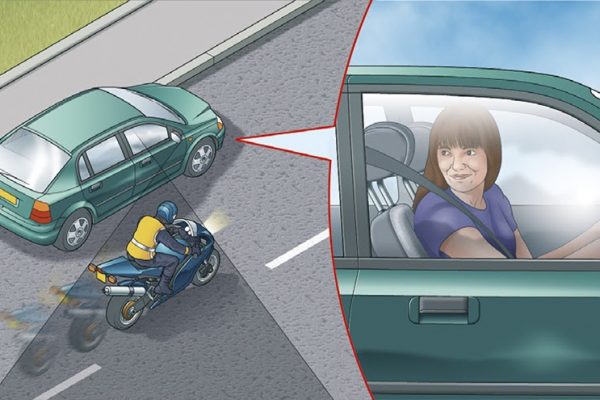Motorcycle filtering or lane splitting is the act of riding between vehicles to make safe progress in slow-moving or stationary traffic.
As our roads continue to become busier and more congested, lane splitting is a practice that you’ve probably considered. But just how legal is this manoeuvre, and what’s the safest way to approach filtering on a motorcycle?

Is Lane Splitting Legal In The UK?
You’ll be pleased to know that lane splitting or filtering is legal in the UK. Despite the lack of any filtering-specific laws, there are mentions of it in the highway code, implying that filtering is allowed on UK roads.
What Does The Highway Code Say?
Rule 160
“Be aware of other road users, especially cycles and motorcycles who may be filtering through the traffic. These are more difficult to see than larger vehicles, and their riders are particularly vulnerable. Give them plenty of room, especially if you are driving a long vehicle or towing a trailer.” [1]
This excerpt from the official gov.uk website clearly mentions filtering, implying that it is a legal manoeuvre. That said, there are no guidelines explicitly aimed at filtering in the highway code, meaning the whole topic is a bit of a grey area.
What Are The Benefits Of Lane Splitting?
Aside from skipping traffic, filtering on a motorcycle is beneficial for riders and those around them. Here are just a few of the key advantages:
Easing Congestion
Safely filtering beside queueing vehicles prevents the need to join the queue, reducing the overall level of congestion.
Shorter queues result in faster travel times (for everyone) and fewer vehicles idling and pumping harmful emissions into the environment.
Safety
While a French study published back in January may suggest otherwise, lane splitting is generally considered a safe practice. Moreover, many riders believe that the risk of being rear-ended in traffic is significantly more dangerous than filtering itself.
Ultimately, we believe that lane splitting with due care poses less risk than queueing in traffic with impatient drivers.
Comfort
Riding a motorcycle on a scorching British summer’s day can be uncomfortable at the best of times. Now imagine being sat in a queue of seemingly never-ending traffic astride a motorcycle nearing 100ºC with no air conditioning.
Queuing in traffic isn’t fun for anyone, but motorcyclists are seriously at risk of exhaustion and heatstroke on warm days. Splitting between lanes alleviates the need to sit in traffic and overheat, substantially increasing your level of comfort.
Motorcycle Filtering Tips & Techniques
As we’ve already alluded to, there is a right and a wrong way to filter on a motorcycle.
Following the highway code’s general guidelines and taking the necessary precautions is crucial for your safety and other road users around you.
Here are six top tips to keep you out of harm’s way and on the right side of the law:
Observations
Before moving into position, make sure to scan the road ahead and perform a shoulder check. It’s crucial to keep an eye out for:
- Motorcyclists that are already filtering
- Debris that may have collected in between the lanes
- Vehicles that may be blocking your path
- Changes in the lane layout (e.g., will you be forced to use a bus lane?)
- Large vehicles (as you may end up in their blind spot)
Once you’re confident that it’s safe to proceed, perform one last shoulder check before moving across. A lot can change in a matter of seconds, so constantly reevaluating the situation will serve you well.
While filtering, be on the lookout for natural gaps in the traffic where it’s safe to merge back into the lane. Some road users may even slow down or move across to let you in, so pay close attention to what’s happening around you.

Speed
In most cases, motorcycle filtering accidents are the result of an inappropriate speed differential. The key to safe lane splitting is keeping the difference in speed between other vehicles and you as minimal as possible.
We recommend filtering at no more than 15mph above the flow of traffic on faster roads, such as motorways. In town, this number should be closer to 5-10mph above, depending on the situation and speed of the traffic.
Space
The situation in traffic is constantly changing, and gaps can form and disappear in the blink of an eye.
Make sure you always have enough clearance on either side and don’t try to squeeze through any tremendously tight gaps! Wing mirrors tend to be pretty easy to break (even at low speed) and quite costly to repair.
Hazards
Scanning ahead for hazards is a crucial part of day-to-day motorcycling, and all the more so when filtering.
- Is a vehicle signalling to switch lanes?
- Could another vehicle emerge from the junction up ahead?
- Is there any gravel or debris in your path?
- Are there any pedestrians crossing in between the traffic?
Other Road Users
Unfortunately, many motorists in the UK are under the false impression that lane splitting is an illegal practice. Even those that know it is legal may still be startled when you seemingly appear out of nowhere.
While you can’t eliminate the possibility of disgruntled drivers, filtering sensibly and being courteous to those around you will help to minimise the risk.
Pedestrian Crossings
While filtering on zig-zags is legal (assuming you don’t pass the vehicle at the front of the queue), it is generally not advised.
People can often be found crossing in between vehicles on the approach to pedestrian crossings, significantly increasing the chance of a collision.
Final Thoughts
When carried out in a safe manner, lane splitting benefits everyone. From easing congestion to lessening pollution and reducing travel times, allowing motorcyclists to split lanes has many clear advantages.
We hope this article has shed some light on the law surrounding filtering in the UK and maybe even helped you improve your technique!
Have you got any lane-splitting tales to share? Get in touch and let us know!
